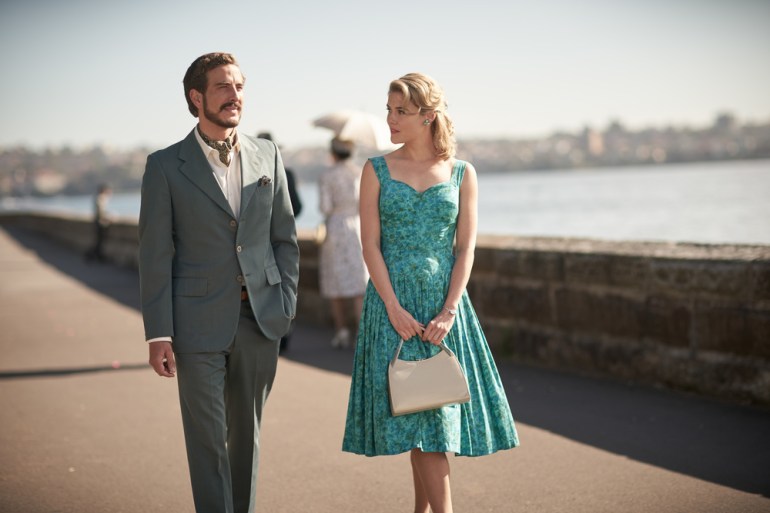Ryan Corr and Rachael Taylor in ‘Ladies in Black.’
The good news for Australian cinema: Last year ranks as the third biggest ever for Oz films and feature docs released theatrically in the home market.
Another encouraging trend: Eight of the top 30 grossing titles were feature docs, led by Paul Damien Williams’ Gurrumul, Mark Joffe’s Jimmy Barnes: Working Class Boy, Ray Argall’s Midnight Oil 1984, Naina Sen’s The Song Keepers and Catherine Scott’s Backtrack Boys.
The not-so-good news: The top two films, Will Gluck’s Peter Rabbit and Bruce Beresford’s Ladies in Black accounted for nearly 70 per cent of total revenues, while 39 of the 61 new releases each made less than $100,000.
Collectively, local titles including holdovers racked up $57.4 million in 2018, trailing the 2001 total of $63.1 million, according to the Motion Picture Distributors Association of Australia (MPDAA)
The all-time record is 2015’s $88.1 million, the year of Mad Max: Fury Road, The Dressmaker and Oddball. Granted, if the prior year tallies such as 2000’s $54.2 million and 2010’s $54.8 million were adjusted for inflation, last year’s result would not rank so highly.
The MPDAA, which estimates 722 films were released theatrically last year – up from 697 in 2017, classifies Joel Edgerton’s Boy Erased as an Australian production.
Majestic Cinemas CEO Kieren Dell observes, “Independent films, especially small Australian ones, struggled on the big screen in 2018 in regional areas. This is despite the increasing willingness of filmmakers and talent to tour the country.
“I don’t know what the answer is to bring audiences back to Australian films but a good start would be to allocate more budget for publicity, as if people don’t know about these great little films, they won’t seek them out. And it might help fund more visits to regional areas.
“I would like to see more broadly accessible Australian films, especially for a family and teenage audience, following Storm Boy – we currently have teenagers in our employ who have never watched an Australian movie. And we need more comedies and light entertainment.”
Hailing the success of feature docs, filmmaker Tom Zubrycki has called on Screen Australia to invest more funds in the sector. ”Feature documentaries are punching above their weight, reflected not only in critical success, but also in the box office in the crowded exhibition sector,” he tells IF. “Eighteen feature docs were released in 2018 and 19 in 2017, while between 2007 and 2011 only 38 documentaries achieved cinema release.
“In the spreadsheet of theatrical releases in 2017-18 supplied by MPDAA, if you look at the films that have earned over $100,000 at the box office, it shows that 12 out of 36 features were documentaries. However, Screen Australia’s production allocation to the documentary sector remains around 18 per cent of the total allocated to production over all the genres.
“In my opinion Screen Australia needs to allocate a greater percentage of its resources towards documentary, both in the development area, and especially to the Producer Program, which has ever-increasing calls on it to support more features.”
As IF has noted the industry should have a rousing start to the year with Shawn Seet’s Storm Boy opening on January 17 followed by Jennifer Kent’s The Nightingale and Anthony Maras’ Hotel Mumbai.
Rachel Ward’s Palm Beach, Kriv Stenders’ Danger Close: The Battle of Long Tan, Owen Trevor’s Go Karts, Gregor Jordan’s Dirt Music, Justin Kurzel’s True History of the Kelly Gang, Rachel Griffiths’ Ride Like a Girl, Jeremy Sims’ Rams and Tony Tilse’s Miss Fisher & the Crypt of Tears all have appealing commercial elements.
And there is plenty of potential among a raft of other titles including Stephen Johnson’s High Ground, Sophie Hyde’s Animals, John Sheedy’s H is for Happiness, Kiah and Tristan Roache-Turner’s Nekrotronic, Unjoo Moon’s I Am Woman, Natalie Erika James’ Relic, Justin Dix’s Blood Vessel, Dean Murphy’s The Very Excellent Mr Dundee and Miranda Nation’s Undertow.
View the scorecard here.



